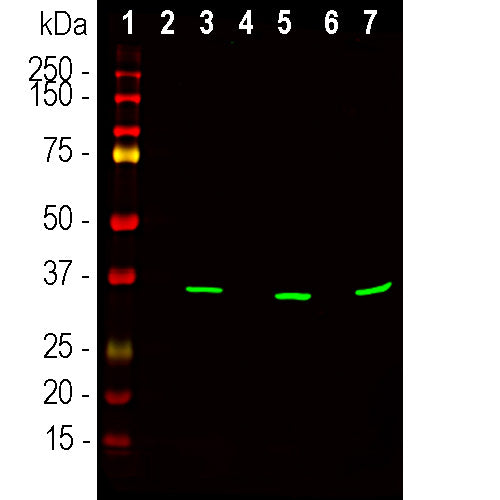
![Western blot analysis of lysates of cell fractions probed with mouse mAb to fibrillarin, MCA-38F3, dilution 1:500 in green: [1] protein standard, [2] C6 cytosol, [3] C6 nuclear, [4] HEK293 cytosol, [5] HEK293 nuclear, [6] NIH-3T3 cytosol and [7] NIH-3T3 nuclear fractions. The band at 37kDa corresponds to the fibrillarin protein detected exclusively in the nuclear fractions.](http://encorbio.com/cdn/shop/files/8280686133500_blot_image_20x_crop_center.jpg?v=1708541173)
EnCor Biotechnology
Mouse Monoclonal Antibody to Fibrillarin, Cat# MCA-38F3
Description
The MCA-38F3 antibody has been widely used as a convenient marker of nucleoli in many different species including human, rat, mouse, zebrafish, C. elegans, D. melanogaster, yeast and many others. We recently mapped the epitope of MCA-38F3 to EYRAWNPFRSKLAAAILGGV, amino acids 133-152 of the human sequence, at the N-terminal of the globular domain, see here. The KD for this antibody in 4.578 X 10-9M. While MCA-38F3 works well as a immunocytochemical marker it gives a relatively weak but still usable western blotting signal on mammalian cell extracts. We recommend other antibodies for western blotting of mammalian tissues such as our mouse monoclonal MCA-4A4, or rabbit and chicken polyclonals, RPCA-Fib and CPCA-Fib. All three were made against recombinant full length human fibrillarin and we document that MCA-4H4 can be used for ICC and IHC.
Add a short description for this tabbed section
| Immunogen: | Yeast nuclear preparation |
| HGNC Name: | FBL |
| UniProt: | P15646 |
| Molecular Weight: | 35kDa |
| Host: | Mouse |
| Isotype: | IgG1 |
| Species Cross-Reactivity: | Human, Rat, Mouse, Drosophila, Caenorhabditis, Saccharomyces |
| RRID: | AB_2278545 |
| Format: | Concentrated hybridoma cell culture media plus 5mM NaN3 |
| Applications: | WB, IF/ICC, IHC |
| Recommended Dilutions: | WB: 1:100-500. ICC: 1:100-500 Not Recommended for IF/IHC |
| Storage: | Store at 4°C for short term, for longer term store at -20°C. Avoid freeze/thaw cycles. Stable for 12 months from date of receipt. |
Fibrillarin is a highly conserved component of a nucleolar small ribonucleoprotein complex in mammals, involved in the processing of ribosomal RNA during ribosomal biogenesis. The protein runs at ~35kDa on SDS-PAGE and is very rich in basic amino acids having a PI of 9.8. An alternate name for the protein is "U3 small nuclear ribonucleoprotein" (U3snRNP). Fibrillarin was originally identified in humans since autoantibodies staining nucleoli were seen in some patients with the autoimmune disease scleroderma (1). Subsequently the protein fibrillarin was found to be the human homologue of Nop1p, a Saccharomyces cerevisiae nucleolar protein, the two proteins being 67% identical (2,3). The MCA-38F3 antibody was made against a nuclear preparation from S. cerevisiae and found to bind the yeast protein Nop1p, and was then found to also bind human fibrillarin (2). The fibrillarin molecule consists of an N-terminal glycine and arginine rich region followed by a highly conserved globular domain. Embryonic knockout of the fibrillarin gene in mice is lethal, suggesting fundamental importance of this protein (4). Autoantibodies to fibrillarin are also seen in patients with the autoimmune disease systemic sclerosis (5)
The antibody has been tested on formalin fixed paraffin embedded sections, and is not recommended for this purpose.
1. Aris JP and Blobel G. Identification and characterization of a yeast nucleolar protein that is similar to a rat liver nucleolar protein. J. Cell Biol. 107:17-31 (1988).
2. Aris JP and Blobel G. cDNA cloning and sequencing of human fibrillarin, a conserved nucleolar protein recognized by autoimmune antisera. Proc. Natl. Acad. Sci. 88:931-5 (1991).
3. Ochs RL, Lischwe MA, Spohn WH, Busch H. Fibrillarin: a new protein of the nucleolus identified by autoimmune sera. Biol. Cell. 54:123-33 (1985).
4. Newton K, Petfalski E, Tollervey D, Caceres JF. Fibrillarin is essential for early development and required for accumulation of an intron-encoded small nucleolar RNA in the mouse. Mol. Cell Biol. 23:8519-27 (2003).
5. Okano Y, Steen VD, Medsger TA. Autoantibody to U3 nucleolar ribonucleoprotein (fibrillarin) in patients with systemic sclerosis. Arth. Rheum. 35:95-100 (1992).
This antibody has been widely used for many years sold through EnCor and through numerous OEM partners- to find such references go to Google Scholar and enter "38F3 AND antibody AND fibrillarin" or go here.
Add a short description for this tabbed section





